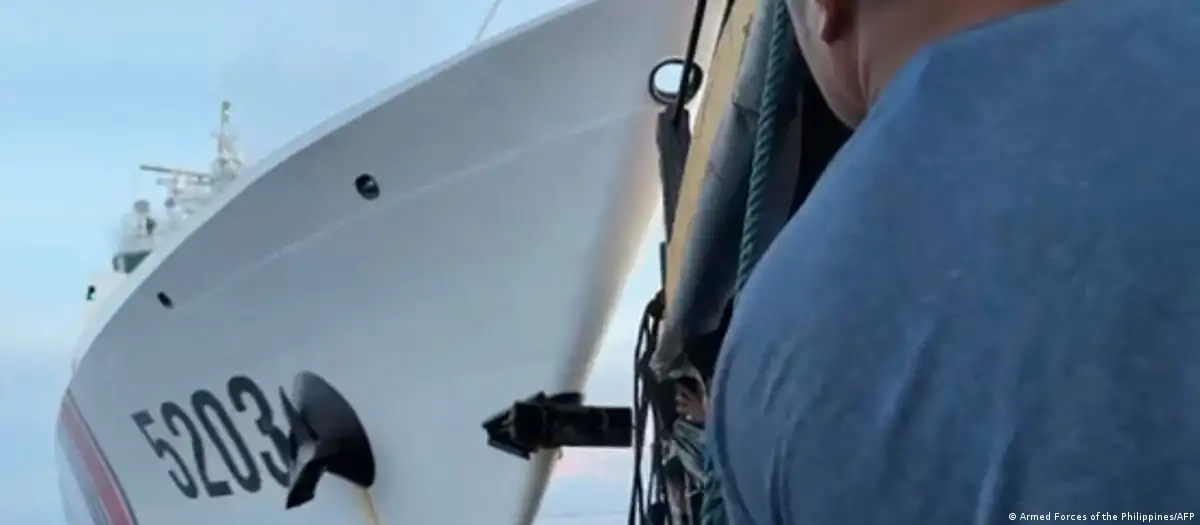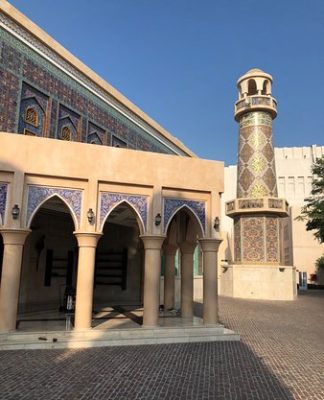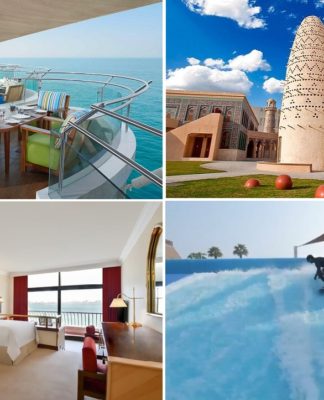CONFLICTSPHILIPPINES
South China Sea: Philippines and China on collision course
Rodion Ebbighausen
10/25/2023October 25, 2023
Ties between China and the Philippines have deteriorated sharply since Philippine President Ferdinand Marcos Jr. praised the two countries’ “friendship” in early 2023.
https://p.dw.com/p/4Y0dV
A man aboard a Philippine ship looks at a Chinese coast guard vessel moments before an impact
China has said its coast guard acted in a ‘professional and restrained’ mannerImage: Armed Forces of the Philippines/AFP
Two nations, four ships and two naval collisions in a single day — last Sunday, a Chinese coast guard ship collided with a vessel resupplying the Philippine military station on the Second Thomas Shoal, which Beijing claims to be in its territorial waters. Then, a Chinese militia vessel hit a Philippine coast guard ship. Nobody was injured.
The Second Thomas Shoal is part of the Spratly Islands, to which many surrounding nations have laid a claim. Manila and Beijing are now trading accusations of violating sovereignty in the disputed waters of the South China Sea.
No more ‘friendship’ and ‘positive energy’
In early 2023, the mood between Beijing and Manila was completely different. Philippine President Ferdinand Marcos Jr. praised the “friendship” between the two sides while meeting China’s Xi Jinping in Beijing in January. In turn, China announced its intentions to contribute “more positive energy to peace and stability in the region.”
Specifically, both Asian nations pledged to create a direct emergency line in order to communicate quickly and easily in case of an escalation in the South China Sea. China also promised to invest some $22 billion (€20.8 billion) in the Philippines.
Just two months later, however, the atmosphere of friendship and positive energy seemed to evaporate. In March, the Philippines accused China of pointing a military laser at a Philippine coast guard ship. In August, the Chinese coast guard fired water cannon at a Philippine vessel. And in early October, China deployed a floating barrier to reduce the Philippines’ access to the Second Thomas Shoal. The Philippines removed the barrier. Now, their ships are colliding in the disputed waters.
Philippines, China tussle in the high seas
02:24
All attempts to reach Beijing via the aforementioned emergency line ended in failure, according to Philippine Foreign Secretary Enrique Manalo.
China wants Manila’s ship to ‘rust away’
The Second Thomas Shoal is around 200 kilometers (124 miles) away from the Philippine island of Palawan. In 1999, Manila purposely ran aground a World War II warship Sierra Madre on the reef, leaving it manned with a handful of marines to reinforce its territorial claim.
The ship is falling into disrepair and is in urgent need of an overhaul. But China has other plans, according to Bill Hayton, associate fellow of the Asia-Pacific Program at Chatham House and editor of the Asian Affairs journal.
“I think they want the ship to rust away. And then the feature would be unoccupied, presumably so that China would then occupy it straight away,” he told DW.
Manila moves closer to US
For China, the issue is much bigger that the reef itself, Hayton added. Under Ferdinand Marcos Jr. the Philippines has been more willing to join forces with the Americans to “try and push back against some of China’s behaviors,” he said.
This new course saw the Philippines expand their defense alliance with the US in April and indicate four potential sites for new US military bases, all of them in the north, close to Taiwan and the South China Sea.
US promises ‘ironclad’ defense of Philippines
03:06
Some observers indicated China may be trying to shore up its claims while the US is distracted by the conflict in Ukraine and the Israel-Hamas war. But Hayton believes the US military has enough “resources to focus on the South China Sea at the same time as other people are looking at other parts of the world.”
Naval row in the public eye
The Philippines has also ramped up the pressure this year with its decision to make the dispute public. Its ships now have camera crews to document naval incidents with China.
And Manila has other cards to play in addition to public pressure. In 2016, an international tribunal in The Hague sided with the Philippines by ruling that rocky outcrops claimed by China in the disputed region cannot be used to justify territorial claims.
Beijing has refused to abide by the ruling, dismissing it as “null and void.”
According to Hayton, China is locked into a “rather foolish” historical narrative that “it owns everything in the South China Sea, despite lots of evidence against that.”
When asked for comment by DW, the Chinese Embassy in Berlin stressed that “Ren’ai Jiao” — the Chinese name for the Second Thomas Shoal — was part of China’s territory.
An areal view of the two ships colliding in the South China SeaAn areal view of the two ships colliding in the South China Sea
The Philippines have published videos of the latest navel incidentsImage: Armed Forces of the Philippines/AP/picture alliance
“The Philippines illegally ‘grounded’ its warship at Ren’ai Jiao. This seriously violates China’s territorial sovereignty,” the Chinese diplomats said, describing the actions of its coast guard as “professional and restrained.”
In turn, the Philippine Embassy in Berlin told DW that the actions of the Chinese coast guard ship were “irresponsible and dangerous” and “imperiled the safety of the crew” of the resupply vessel.
Beijing accuses Manila of going back on its promise
A new aspect of the decadeslong conflict has recently been in the public eye, with China insisting that the Philippines had pledged to remove its warship years ago and then failed to honor its promise. This narrative started making the rounds in the Philippines this summer after it was published by columnist Rigoberto Tiglao.
According to the columnist, Joseph Estrada, who was the president of the Philippines in 1999, had pledged to remove the vessel. But Tiglao did not provide evidence for it and the Philippine officials said he was simply quoting an unsubstantiated claim by China.
President Ferdinand Marcos Jr. has also addressed the reports, saying he was “not aware of any such arrangement or agreement that the Philippines will remove from its own territory its ship” and said that if such an accord does exist “I rescind that agreement now.”
But in their response to DW, Chinese officials restated that Manila “explicitly promised several times to tow away the military vessel” but instead has “sought to repair and reinforce it on a large scale in order to permanently occupy” the location.
What happens next?
There are “very easy ways on paper” to solve the disputes in the South China Sea, according to Chatham House expert Hayton. The simplest way out is for all sides to accept the status quo and allow their rivals to continue to control whatever islands, reefs and sand atolls they control already, he said. Any disputes over resources could be resolved in the framework of the international naval law and the United Nations Convention on the Law of the Sea.
This outcome seems unlikely amid the current tensions. Until a permanent solution is found, rivals in the disputed region seem destined to set claim against claim and ship against ship.
This article was originally written in German
Adapted for English by: Darko Janjevic
Edited by: Keith Walker






























